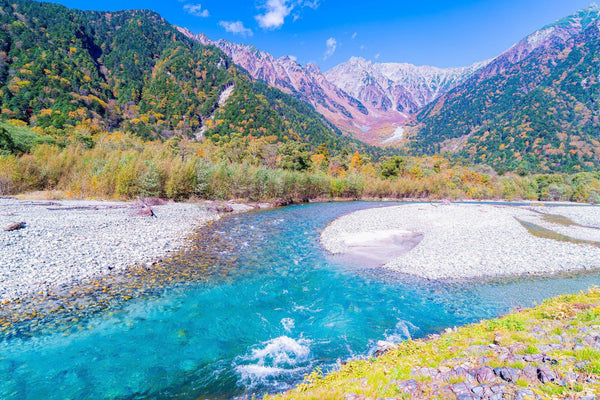
Jump to:
Japan is famous for being a very mountainous country. In fact, only about 33% of Japan’s land is inhabitable, which is in stark contrast to 88% in countries like the United Kingdom. While this means that people tend to live in close proximity to each other, it has the converse positive effect that there are many vast and beautiful areas of nature to enjoy, and Japan’s mountains are particularly worth exploring. In an effort to preserve these places of beautiful scenery and nature, the first national parks were created in Japan in the early 1930s. In this post, we shall describe some of the top national parks that should be on your bucket list to visit in the various regions of Japan. Our tour will take us all the way from Okinawa in the south to Hokkaido on the northern tip of Japan, so buckle up!
National Parks In Okinawa And Nearby Islands
Yambaru National Park

Starting with the Japanese mainland, the Yambaru National Park is a sparsely populated park the size of approximately 135 m2, situated in a subtropical forest in the northern part of Okinawa Island. A relatively young park, this was established on September 15, 2016. Due to Okinawa’s mild climate, its beautiful wildlife and fauna can be enjoyed the whole year round.
Kerama Shoto National Park

If swimming, snorkeling, and diving at beautiful beaches is more your thing, then we would also recommend the Kerama Shoto National Park in the Kerama islands situated 40 km off of Okinawa's main island, or the larger Iriomote-Ishigaki National Park, where you can also enjoy kayaking along mangrove swamps. Although Okinawa’s climate is mild to warm the whole year round, if you are going there for the marine sports, you would probably be better off avoiding the winter months.
Amami-Gunto National Park

The Amami Gunto National Park, although technically part of Kagoshima Prefecture, covers eight islands stretching from Okinawa to Kyushu over an area of approximately 420 km2. The park offers a full range of interesting activities, and the best time to visit will depend on the purpose of your visit. If whale watching is your thing, then December to March is best. On the other hand, July to September will be better if you wish to swim in the sea and enjoy the beaches. There are also many traditional events to enjoy in the fall.
National Parks In Kyushu
Yakushima National Park

Our journey now takes us up to Kyushu on the southern tip of the Japanese archipelago, but we shall start by looking at the Yakushima National Park, which is on the island of the same name approximately 300 km south of Kagoshima Prefecture on the mainland (of which it is a part). The island is approximately 500 km2 in size, and the park occupies approximately two-thirds of this. Its main attraction is its ancient trees, including the 7000-year-old Jomonsugi tree. Summer is a popular time to visit due to the slightly cooler temperatures compared to other areas of Japan, but it gets plenty of rain so don’t forget to pack your waterproofs!
Aso-Kuju National Park

Moving on to mainland Kyushu, the national parks on the island are characterized by the extraordinary natural beauty brought about by its volcanoes. These include, from the largest to the smallest, the Aso-Kuju, Kirishima Kinkowan, and Unzen Amakusa national parks. At over 700 km2 in size, the Aso-Kuju National Park spans Oita and Kumamoto prefectures in Central Kyushu. Visitors can not only enjoy exploring the volcanic craters on their hiking trips, but also enjoy one of the more pleasant by-products of volcanoes, the excellent hot springs in the nearby towns. It is recommended you visit the park between May and October, and as azaleas bloom in early summer, the park is particularly beautiful at this time of year as well.
Kirishima Kinkowan National Park

The Kirishima Kinkowan National Park covers approximately 365 km2 across the southern Kyushu prefectures of Kagoshima and Miyazaki and combines coastal areas with the Sakurajima and Kirishima volcanoes. Kirishima is particularly important in Japanese mythology. The best time to visit the park is in the spring when the mountains bloom with azaleas and Malus spontanea, a wild rose that is only found here.
Unzen Amakusa National Park

Last, but by no means least, is the Unzen Amakusa National Park, famous for Mount Unzen, an active volcano that actually erupted during the 1990s. The best place to visit the mountain is probably late October to the middle of November when hikers can enjoy the autumn leaves in full color.
National Parks In The Chugoku Region
Daisen Oki National Park

The Daisen Oki National Park consists of over 300 m2 split into four areas: the Mt. Daisen and Hiruzen area, the Oki islands, the Shimane Peninsula, and the Mt. Sanbe area. Spring is considered to be the best time to visit, as you can see Japanese giant salamanders in their natural habitat, wander through the beech trees of Mt. Daisen, and explore the sea caves on the Oki islands.
Setonaikai National Park

The Setonaikai National Park mainly consists of a 400 km area of the Seto inland sea, from the Naruto whirlpools to Miyajima (near Hiroshima). It also includes various islands such as Naoshima and Shodoshima.
Sanin-Kaigan National Park

Whereas the Setonaikai National Park is actually in the sea, the Sanin Kaigan National Park stretches across 75 km of coastline from Tottori to Kyotango, covering Tottori, Hyogo, and Kyoto Prefectures. There is a large pond called "Hebi-no-ike" (Snake Pond) on Mt. Gokurakuji, where about 500 water lilies are planted. During the rainy season, red, white, and other colored flowers that are pleasing to the eye open, so the end of June and the start of July would be a good time to visit.
National Parks In The Kansai Region
Ise-Shima National Park

The Kansai region boasts two national parks of particular note: The Ise-Shima National Park and the Yoshino Kumano National Park. The former is an impressive size of 555 km2, within Mie Prefecture and includes both the Shima Peninsula, which is famous for its pearl cultivation, and Ise shrine, one of the most important and sacred shrines in Japan. The park is beautiful the whole year around, but between May and July, you are able to see the sunrise between the two Meoto Iwa Rocks, which is a spectacular sight.
Yoshino-Kumano Park

As the Yoshino Kumano Park, which is almost 600 km2 in size, boasts the most famous cherry blossom spot in Japan (Mt. Yoshino), it figures that spring is the best time to visit, with peak viewing time normally being late March to the middle of April. The park also prides itself on housing the sacred Kumano region, and this along with Mt. Yoshino is a UNESCO World Heritage Site.
National Parks In The Chubu Region
Fuji Hakone Izu National Park

The Fuji Hakone Izu National Park offers something for everyone, which probably accounts for it being the most visited national park in Japan. Covering Yamanashi, Shizuoka, and Kanagawa Prefectures, this approximately 1200 km2 park offers mountain climbing and kayak cruising tours of the Izu peninsula, as well as the Hakone Geo Park. The best time to visit depends on your purpose in going. Hiking is best in summer whereas the winter months of December to February offer the best views of Mt. Fuji.
Hakusan National Park

Hakusan National Park is smaller, at 477 km2, and is centered around Mt. Hakusan, a 2700 m tall dormant volcano that is considered one of the three sacred mountains of Japan. As the main purpose of visiting this park is to climb the mountain, or at least some of the mountain, we would recommend visiting it between June and October, which is the climbing season.
Chubu Sangaku National Park

The 1,743 m2 Chubu Sangaku National Park straddles Nagano, Gifu, Niigata, and Toyama prefectures, and its beautiful mountain scenery has led to it being given the name, “The Northern Alps.” It is recommended that you visit the park between the months of May and October.
National Parks In The Kanto Region
Oze National Park

The Oze National Park borders the four prefectures of Gunma, Fukushima, Niigata, and Tochigi, and the park, which is itself over 370 km2 in size, consists mainly of a large marshland area at an altitude of 1400 meters. As it is covered in deep snow during the winter, it is probably best avoided at this time.
Ogasawara National Park

The Ogasawara islands are a World Heritage Site located approximately 1,000 km from Tokyo covering an area of approximately 66 km2. As the main activities there are sea-based, such as whale and dolphin watching, as well as kayaking, snorkeling and diving, the warmer summer months are recommended when visiting.
Nikko National Park

The Nikko National Park, which is just over 1000 km2 and within day-trip distance from Tokyo, is a great place to visit for culture, with the Toshogu Shrine, and for relaxation with its waterfalls, hot springs and beautiful hiking trails. The ideal time to visit the park is October to mid-November when the beautiful autumn flowers begin to bloom.
National Parks In The Tohoku Region
Sanriku Recovery Park

Moving up to the Tohoku region, the Sanriku Recovery Park was renamed in 2013 as part of initiatives to rebuild the area after the catastrophic 2011 tsunami, which caused huge devastation and loss of life along the Sanriku Coast. The beautiful coastline of this 285 m2 park is its main attraction. Again, the best time to go depends on what you are looking for. If you want to view a snow globe of mountains, go in winter. If you want to hike, spring may be the best time in terms of temperature, but the colors of the flowers are more vibrant in the summer.
Bandai Asahi National Park

The area of the Bandai Asahi National Park, centered around Mount Bandai, is 1,870 m2, and it stretches across four separate volcanic regions in Fukushima, Yamagata, and Niigata prefectures. While you can enjoy walking or hiking in the summer, if you are into skiing and other similar pursuits, winter is definitely the time to go.
Towada Hachimantai National Park

If you are looking for some of the top hot springs in the country, however, the Towada Hachimantai National Park may be the place for you. Covering over 800 m2 across Aomori, Akita, and Iwate prefectures, it combines Lake Towada and the Hachmantai mountains, and is famous for the amazing color of its foliage in autumn.
Hokkaido’s National Parks
Daisetsuzan National Park

The largest of the 34 national parks in Japan, Daisetuzan National Park, at over 2000 km2 is approximately the same size as Kanagawa Prefecture and was designated as a national park in 1934. The park is home to 16 peaks over 2000 meters high and the two longest waterways, the Ishikari and Tokachi rivers originate from the park. The best time to visit the park is late August or early September, where you can see the autumn Koyo foliage, which comes earlier than anywhere else in Japan, in its glorious best.
Akan Mashu National Park

The Akan Mashu National Park, which is 900 km2 in size, centers around its three lakes, including Lake Mashu one of the most stunning lakes in Japan, surrounded by volcanoes. Because of the climate, the optimal time for visiting this park is June to September, where you can enjoy climbing the mountain trails, but go there in the winter and you can enjoy ice fishing.
Kushiro Shitsugen National Park

If you want to observe rare birds, then the Kushiro Shitsugen National Park may be a good choice as the wetlands and marshes of this 268 km2 park are home to an endangered species of Japanese cranes. The cranes can be observed the whole year round.
Shiretoko National Park

Another national park in Hokkaido where you can view animals is the Shiretoko National Park, which covers 386 km2. It is recommended that you visit the park in summer, when you can view the bears from sightseeing boats.
Rishiri Rebun Sarobetsu National Park

Lastly, is the Rishiri Rebun Sarobetsu National Park, which occupies an area of 212km2, covering the two islands of Rishiri and Rebun, near the northernmost tip of Hokkaido. The best time to visit the park is June to August when the blossoming of the alpine flora of the islands is at its peak.
Japan’s National Parks- An Abundance Of Nature For You To Enjoy
As I hope this article has demonstrated, whatever area of Japan you happen to be in, there is a host of wonderful nature sports for you to visit and enjoy. And the good news is that this post has barely scratched the surface of the incredible destinations in Japan, so I would encourage you to get out there and experience all Japan has to offer.
Have you visited a national park in Japan that left a lasting impression on you? If so, please share your experiences in the comments.


0 comments